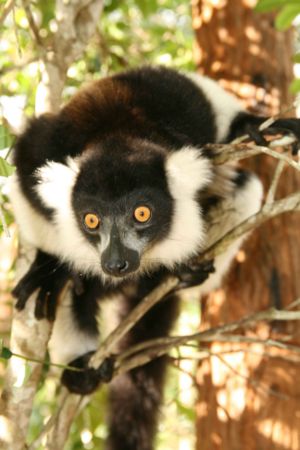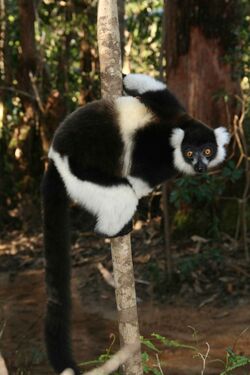Varecia variegata (Black-and-white Ruffed Lemur): Difference between revisions
imported>Lee R. Berger |
imported>Lee R. Berger |
||
| Line 5: | Line 5: | ||
==Description== | ==Description== | ||
The Black and white ruffed lemur is a diurnal [[Primate]] that has a head body length of approximately 43 – 57 cm and a tail length of around 60-65 cm<ref name="Fleagle">{{cite book|title=Primate Adaptation and Evolution|accessdate=|author=J. Fleagle|authorlink= |coauthors= |date=1998 |format= |work= |publisher=Academic Press: New York|pages= |language= |archiveurl= |archivedate= |quote= }}</ref><ref name="Szalay">{{cite book |title=Evolutionary History of the Primates|accessdate=|author=F. Szalay and E. Delson|authorlink= |coauthors= |date=2001 |format= |work= |publisher=Academic Press, New York|pages= |language= |archiveurl= |archivedate= |quote= }}</ref><ref name="Mittermeier">{{cite book|title=Lemurs of Madagascar|accessdate=|author=Mittermeier et al.|authorlink= |coauthors= |date=2006 |format= |work= |publisher=Conservation International|pages= |language= |archiveurl= |archivedate= |quote= }}</ref>. Weight ranges between approximately 3 and 3.5 kg<ref name= "Mittermeier"/>. Coat color, as the | The Black and white ruffed lemur is a diurnal [[Primate]] that has a head body length of approximately 43 – 57 cm and a tail length of around 60-65 cm<ref name="Fleagle">{{cite book|title=Primate Adaptation and Evolution|accessdate=|author=J. Fleagle|authorlink= |coauthors= |date=1998 |format= |work= |publisher=Academic Press: New York|pages= |language= |archiveurl= |archivedate= |quote= }}</ref><ref name="Szalay">{{cite book |title=Evolutionary History of the Primates|accessdate=|author=F. Szalay and E. Delson|authorlink= |coauthors= |date=2001 |format= |work= |publisher=Academic Press, New York|pages= |language= |archiveurl= |archivedate= |quote= }}</ref><ref name="Mittermeier">{{cite book|title=Lemurs of Madagascar|accessdate=|author=Mittermeier et al.|authorlink= |coauthors= |date=2006 |format= |work= |publisher=Conservation International|pages= |language= |archiveurl= |archivedate= |quote= }}</ref>. Weight ranges between approximately 3 and 3.5 kg<ref name= "Mittermeier"/>. Coat color, as the common name suggests, is black and white. <ref name= "Mittermeier"/>. The coat and tail are fluffy and the black and white ruffed lemur has prominent "tuffs" on the ears<ref name= "Mittermeier"/>. There are no size or color differences that distinguish males from females. | ||
==Behaviour== | ==Behaviour== | ||
Revision as of 03:08, 7 September 2007

The Black and white ruffed lemur Varecia variegata variegata is a large quadrupedal Lemur. In the wild, it is found only on the island of Madagascar.
Description
The Black and white ruffed lemur is a diurnal Primate that has a head body length of approximately 43 – 57 cm and a tail length of around 60-65 cm[1][2][3]. Weight ranges between approximately 3 and 3.5 kg[3]. Coat color, as the common name suggests, is black and white. [3]. The coat and tail are fluffy and the black and white ruffed lemur has prominent "tuffs" on the ears[3]. There are no size or color differences that distinguish males from females.
Behaviour
Studies show significant variation in group size and territorial behaviour [2][3]. The black and white ruffed lemur moves mostly quadrupedally but is also an adept leaper[3]. It has been noted that this species is possibly the only Primate to build nests exclusively for the birth of young[3].
Diet
It is highly frugiverous but also eats seeds, leaves and nectar [2][3].
Geographical distribution
The black and white ruffed lemur may be found in small areas of tropical moist lowland and montane forests of eastern Madagascar[3].
Status
The black and white ruffed lemur is considered to be critically endangered by the IUCN.
External links
References
- ↑ J. Fleagle (1998). Primate Adaptation and Evolution. Academic Press: New York.
- ↑ 2.0 2.1 2.2 F. Szalay and E. Delson (2001). Evolutionary History of the Primates. Academic Press, New York.
- ↑ 3.0 3.1 3.2 3.3 3.4 3.5 3.6 3.7 3.8 3.9 Mittermeier et al. (2006). Lemurs of Madagascar. Conservation International.
